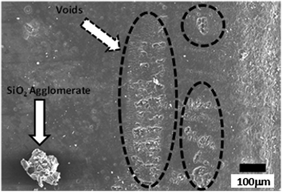Crossref Citations
This article has been cited by the following publications. This list is generated based on data provided by
Crossref.
Healy, Andrew V.
Fuenmayor, Evert
Doran, Patrick
Geever, Luke M.
Higginbotham, Clement L.
and
Lyons, John G.
2019.
Additive Manufacturing of Personalized Pharmaceutical Dosage Forms via Stereolithography.
Pharmaceutics,
Vol. 11,
Issue. 12,
p.
645.
Wei, Peiran
Leng, Houming
Chen, Qiyi
Advincula, Rigoberto C.
and
Pentzer, Emily B.
2019.
Reprocessable 3D-Printed Conductive Elastomeric Composite Foams for Strain and Gas Sensing.
ACS Applied Polymer Materials,
Vol. 1,
Issue. 4,
p.
885.
Espera, Alejandro H.
Dizon, John Ryan C.
Chen, Qiyi
and
Advincula, Rigoberto C.
2019.
3D-printing and advanced manufacturing for electronics.
Progress in Additive Manufacturing,
Vol. 4,
Issue. 3,
p.
245.
Dizon, John Ryan C.
Valino, Arnaldo D.
Souza, Lucio R.
Espera, Alejandro H.
Chen, Qiyi
and
Advincula, Rigoberto C.
2019.
Three-dimensional-printed molds and materials for injection molding and rapid tooling applications.
MRS Communications,
Vol. 9,
Issue. 4,
p.
1267.
Valino, Arnaldo D.
Dizon, John Ryan C.
Espera, Alejandro H.
Chen, Qiyi
Messman, Jamie
and
Advincula, Rigoberto C.
2019.
Advances in 3D printing of thermoplastic polymer composites and nanocomposites.
Progress in Polymer Science,
Vol. 98,
Issue. ,
p.
101162.
SARAÇ, Mehmet
ORANLI, Aslı
AKTİTİZ, İsmail
SAYGI YALÇIN, Berrin
and
VAROL, Remzi
2019.
3B Basılabilir Füme Silika Takviyeli Foto-Duyarlı Polimerlerin Mekanik Özelliklerinin İncelenmesi.
Düzce Üniversitesi Bilim ve Teknoloji Dergisi,
Vol. 7,
Issue. 3,
p.
1793.
Chen, Qiyi
Zhao, Jiayu
Ren, Jingbo
Rong, Lihan
Cao, Peng‐Fei
and
Advincula, Rigoberto C.
2019.
3D Printed Multifunctional, Hyperelastic Silicone Rubber Foam.
Advanced Functional Materials,
Vol. 29,
Issue. 23,
Espino, Michaela Tayag
Tuazon, Brian Jumaquio
Robles, Gerald Sanqui
and
Dizon, John Ryan Cortez
2020.
Application of Taguchi Methodology in Evaluating the Rockwell Hardness of SLA 3D Printed Polymers.
Materials Science Forum,
Vol. 1005,
Issue. ,
p.
166.
Delda, Ray Noel M.
Tuazon, Brian Jumaquio
and
Dizon, John Ryan Cortez
2020.
Assessment of Interfacial Adhesion of Adhesively Bonded 3D-Printed Thermoplastics.
Materials Science Forum,
Vol. 1005,
Issue. ,
p.
157.
Maalihan, Reymark D.
Pajarito, Bryan B.
and
Advincula, Rigoberto C.
2020.
3D-printing methacrylate/chitin nanowhiskers composites via stereolithography: Mechanical and thermal properties.
Materials Today: Proceedings,
Vol. 33,
Issue. ,
p.
1819.
Nath, Shukantu Dev
and
Nilufar, Sabrina
2020.
An Overview of Additive Manufacturing of Polymers and Associated Composites.
Polymers,
Vol. 12,
Issue. 11,
p.
2719.
Chen, Qiyi
Sukmanee, Thanyada
Rong, Lihan
Yang, Matthew
Ren, Jingbo
Ekgasit, Sanong
and
Advincula, Rigoberto
2020.
A Dual Approach in Direct Ink Writing of Thermally Cured Shape Memory Rubber Toughened Epoxy.
ACS Applied Polymer Materials,
Vol. 2,
Issue. 12,
p.
5492.
Lopez de Armentia, Sara
del Real, Juan Carlos
Paz, Eva
and
Dunne, Nicholas
2020.
Advances in Biodegradable 3D Printed Scaffolds with Carbon-Based Nanomaterials for Bone Regeneration.
Materials,
Vol. 13,
Issue. 22,
p.
5083.
Chen, Qiyi
Han, Lu
Ren, Jingbo
Rong, Lihan
Cao, Pengfei
and
Advincula, Rigoberto C.
2020.
4D Printing via an Unconventional Fused Deposition Modeling Route to High-Performance Thermosets.
ACS Applied Materials & Interfaces,
Vol. 12,
Issue. 44,
p.
50052.
Tuazon, Brian Jumaquio
Espino, Michaela Tayag
and
Dizon, John Ryan Cortez
2020.
Investigation on the Effects of Acetone Vapor-Polishing to Fracture Behavior of ABS Printed Materials at Different Operating Temperature.
Materials Science Forum,
Vol. 1005,
Issue. ,
p.
141.
Advincula, Rigoberto C.
Dizon, John Ryan C.
Chen, Qiyi
Niu, Ivy
Chung, Jason
Kilpatrick, Lucas
and
Newman, Reagan
2020.
Additive manufacturing for COVID-19: Devices, materials, prospects, and challenges.
MRS Communications,
Vol. 10,
Issue. 3,
p.
413.
Tijing, Leonard D.
Dizon, John Ryan C.
Ibrahim, Idris
Nisay, Arman Ray N.
Shon, Ho Kyong
and
Advincula, Rigoberto C.
2020.
3D printing for membrane separation, desalination and water treatment.
Applied Materials Today,
Vol. 18,
Issue. ,
p.
100486.
Ghilan, Alina
Chiriac, Aurica P.
Nita, Loredana E.
Rusu, Alina G.
Neamtu, Iordana
and
Chiriac, Vlad Mihai
2020.
Trends in 3D Printing Processes for Biomedical Field: Opportunities and Challenges.
Journal of Polymers and the Environment,
Vol. 28,
Issue. 5,
p.
1345.
Dizon, John Ryan Cortez
Valino, Arnaldo D.
Souza, Lucio R.
Espera, Alejandro H.
Chen, Qiyi
and
Advincula, Rigoberto C.
2020.
3D Printed Injection Molds Using Various 3D Printing Technologies.
Materials Science Forum,
Vol. 1005,
Issue. ,
p.
150.
Chen, Fuping
Li, Ruiqi
Sun, Jingxian
Lu, Guoqiang
Wang, Jin
Wu, Bing
Li, Jingfang
Nie, Jun
and
Zhu, Xiaoqun
2021.
Photo‐curing 3D printing robust elastomers with ultralow viscosity resin.
Journal of Applied Polymer Science,
Vol. 138,
Issue. 10,



